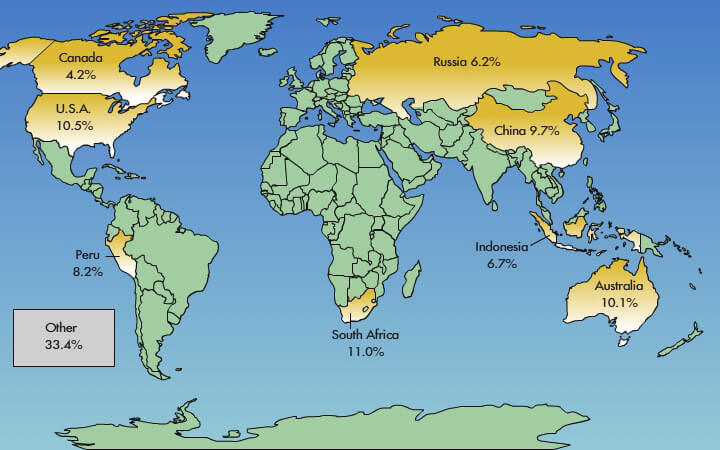To understand the Geographical Distribution of Gold and where is the most gold in the world you must start with the British Isles, where gold is found in some of the streams of Cornwall and in lodes and river gravels near Dolgelly and in other parts of Wales, in Sutherlandshire, and near Leadhills in Scotland, and in the County of Wicklow. On the Continent of Europe, gold is most abundant in Hungary and Transylvania, where the gold occurs in quartz lodes contained in eruptive rocks of tertiary age, chiefly propylite, porphyry, diorite, and granite. The minerals occurring with the gold are galena, blende, and pyrites. In the German Empire, the gold obtained is chiefly derived from the smelting of argentiferous galena in which small quantities of the more precious metal are contained. In Italy the only important mines are those of Pestarena and Val Toppa in North Piedmont, near Monte Rosa. The pyritic ores from these mines are treated by amalgamation. Gold is also found in the sands of the Rhine, the Reuss, the Aar, and other rivers, and in small quantities in Sweden and Finland. A little gold comes from Spain (Corunna) and Servia.
The gold-bearing districts of Russia are (1) the Urals, (2) Siberia, Eastern and Western, whilst an insignificant amount is also derived from Finland and from the Caucasus. The gold was formerly derived chiefly from lodes both in the Urals and in Western Siberia, but is now almost entirely produced by the placers of Siberia.
In India, almost all the gold now being produced is derived from the quartz lodes of the Colar goldfield, Mysore, in Southern India, in which work was begun in the year 1880. A little gold also comes from the Presidencies of Madras and Bombay. In China, Korea, and Japan considerable quantities of gold are produced; little is known of the methods used and of the’ amount produced in China. Some gold is obtained from the auriferous sands of Bokhara. Among other gold-producing districts of Asia and the adjoining islands may be mentioned Annam and other countries in French China, the Malay Peninsula, the islands of Borneo, Celebes, Sumatra, Mindanao in the Philippines, and New Guinea.
From the United States a large percentage of the total gold production of the world is obtained. The chief producing States are California, Colorado, Dakota, Montana, Alaska, Arizona, and Utah, but smaller amounts come from many other States. The produce is now far more from lodes than from placer deposits, and in the treatment of auriferous quartz and pyritic ores almost all the known methods of treatment are applied in different localities. Canada (Yukon Territory, British Columbia, Nova Scotia and Ontario) produces large quantities of gold, and gold ores are also found in various parts of Mexico, Colombia, Bolivia, Chili, Venezuela, Brazil, Peru, and the small States of Central America. The production of several of these countries was formerly much larger than it is at the present day, the reduction being especially marked in the cases of Brazil and Venezuela.
Gold is somewhat widely distributed in Africa, the chief sources of production in former times being the placer deposits of the Gold Coast and Abyssinia. The discoveries of auriferous conglomerates in the Transvaal since 1884 have converted that region into one of the most important among gold producing countries. Rhodesia is becoming a large producer, and gold is also derived from the Gold Coast and the Ivory Coast. Egypt and Madagascar are in course of development and the Soudan is expected to yield considerable amounts in the future.
Gold is found in all the Colonies of Australia, together with Tasmania and New Zealand. In Western Australia, Kalgoorlie or East Coolgardie is by far the richest goldfield. Other important districts are Murchison. Mount Margaret, North Coolgardie, East Murchison and Coolgardie. The chief gold producing districts of Queensland are Charters Towers, Rockhampton (where the Mount Morgan mine is situated), Croydon, and Gympie. Almost all the gold is produced from the quartz mines, the placers having been practically exhausted. The chief producing districts in Victoria are Ballarat, Sandhurst (Bendigo), Beech worth, Maryborough, Castlemaine, Gippsland, and Ararat.
